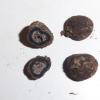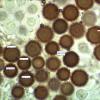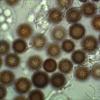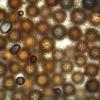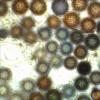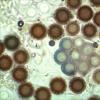
28-12-2025 12:08
Margot en Geert VullingsThis possible Karstenia was found on the bark of d

21-12-2025 21:32
Pol DebaenstHello, Garden, Burgweg 19, Veurne, BelgiumOn 10/1

26-12-2025 21:19
Arnold BüschlenPithyella chalaudii Priou. Ist als Bryoparasit in

21-12-2025 09:32
Hello.A tiny ascomycete found embedded in wood in

18-12-2025 21:17
Pol DebaenstThe identification took me to Byssonectria deformi

24-12-2025 17:08
Hulda Caroline HolteHello, I have found this propoloid ascomycete on

... found on Wednesday in a mixed stand of Populus tremula, Betula, Corylus and Salix caprea (etc.), on slightly acid soil, by the dogs Jule and Millie of Sabine Hörnicke. I fail to determine the specimen that seems to be most close to E. papillatus (that we also found without a lot of doubt at another locality) but differs in the more striate spores (I know there is a variety striatosporus) that are even smaller (I measure about 9,5-12 µm without the ornament being 2 µm and more) and the peridium being blue in section, as well as are some of the spores mounted. In the field, I opened only more or less older ascomata - the best one I cut "at home" in my hotel room. It contained fully ripe and unripe asci and was very interesting to study.
Can somebody help me with the determination? Is it (atypical?) papillatus var. striatosporus?
Best regards from Lothar
P.S. By the way: does somebody know a modern key or monography of Pachyphloeus. My determinations of citrinus and ligericus are a little bit unclear to me with Montecchi alone.
